Gaming isn’t just about stunning visuals and high-octane action anymore; crystal-clear audio is paramount. Whether you’re shouting commands to your teammates or streaming to an audience that hangs on your every word, the right microphone can make all the difference. Quality sound can elevate your gaming experience, making it more immersive and professional. But with so many options on the market, how do you choose the best one? We’ve sifted through the tech jargon to bring you a list of the best external microphones for gaming, ensuring your voice is heard loud and clear across every digital battlefield.
When it comes to finding the best external microphone for gaming, there are several criteria to consider to ensure you capture clear and high-quality audio for an immersive gaming experience. Here are the key factors to keep in mind while selecting the right mic:
- Audio Quality: The most crucial factor is the ability to deliver crisp and clear sound without any static or background noise.
- Pickup Pattern: The microphone’s pickup pattern will determine how sound is captured from different directions. Cardioid patterns are typically preferred for gaming as they pick up sound from the front and minimize background noise.
- Connectivity: USB microphones are the most convenient for plug-and-play use, though some may prefer analog connections (like XLR) for higher sound quality, which requires additional audio interface equipment.
- Build Quality: A sturdy microphone that can withstand regular use is a must. Look for durable materials and a solid stand or mounting options.
- Compatibility: Ensure the microphone is compatible with your gaming platform, whether it’s PC, console, or mobile.
- Latency: Lower latency is paramount to avoid delays in voice transmission, ensuring real-time communication with other players.
- Ease of Use: Features like mute buttons, volume controls, and LED indicators can greatly enhance usability.
- Price: Get the best microphone you can afford, but balance cost with features and performance needed for your gaming setup.
Using this criteria will help you narrow down the options to find the best external microphones tailored to your gaming needs.
Please note that the prices are approximate and can vary based on the retailer and current deals or promotions.
| Features/Specs | Blue Yeti USB Microphone | HyperX QuadCast | Rode NT-USB | Elgato Wave 3 | Audio-Technica AT2020USB+ |
|---|---|---|---|---|---|
| Price (Approx.) | $130 | $140 | $170 | $160 | $150 |
| Polar Patterns | Cardioid, Bidirectional, Omnidirectional, Stereo | Cardioid, Bidirectional, Omnidirectional, Stereo | Cardioid | Cardioid | Cardioid |
| Connectivity | USB | USB | USB | USB | USB |
| Compatibility | PC, Mac | PC, Mac, PS4 | PC, Mac | PC, Mac | PC, Mac |
| Frequency Response | 20Hz – 20kHz | 20Hz – 20kHz | 20Hz – 20kHz | 70Hz – 20kHz | 20Hz – 20kHz |
| Sampling Rate | 16-bit/48kHz | 16-bit/48kHz | 16-bit/48kHz | 24-bit/96kHz | 16-bit/44.1kHz or 48kHz |
| Features | Mute button, Gain control, Zero-latency headphone output | Mute button, Gain control, Shock mount, Pop filter, Zero-latency headphone output | Pop shield, Tripod desk stand, Ring mount, Zero-latency monitoring | Clipguard technology, Capacitive mute, Wave Link software, Zero-latency monitoring | Mix control, High-output internal headphone amplifier, Tripod desk stand |
This table aims to give you a simplified overview, so you have a solid starting point from which you can further explore individual reviews or product demos to find which microphone suits your gaming needs best.
Blue Yeti USB Microphone
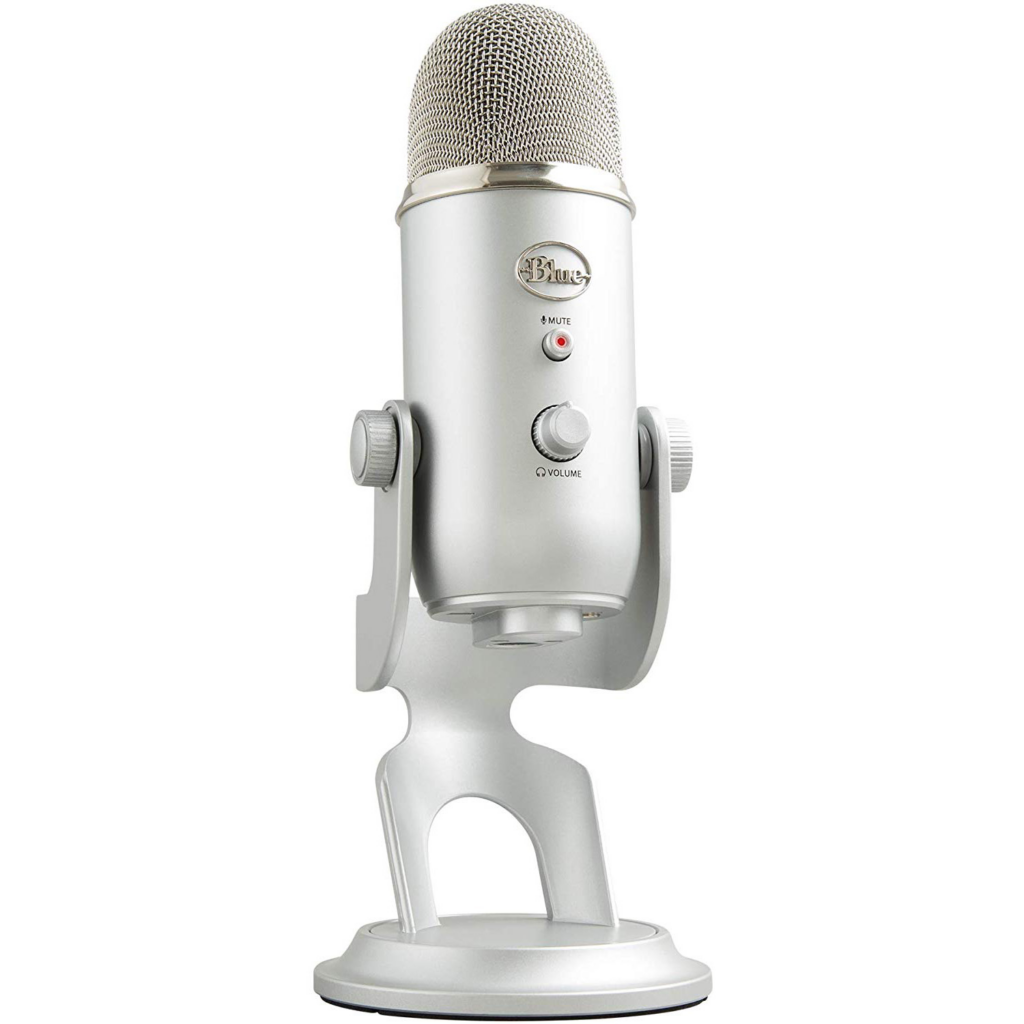
The Blue Yeti is one of the most popular USB microphones on the market, and it’s no wonder why it’s a favorite among gamers. Its sleek design coupled with its exceptional audio quality makes it a fantastic choice for anyone looking to up their game in online multiplayer or streaming. First off, the Yeti’s ease of use is exemplary; with its plug-and-play operation, you don’t need to be an audio engineer to get started. Its versatility is also unmatched, with multiple pattern settings—cardioid, bidirectional, omnidirectional, and stereo—making it perfect for everything from game streams to podcasts.
In my personal use, I’ve found that the Yeti delivers clear, professional sound quality that’s head and shoulders above standard built-in computer mics. Its solid build quality feels premium, and the on-mic controls for volume, pattern selection, and mute are intuitive and handy during intense gaming sessions.
Specs:
- Microphone Type: Condenser
- Polar Patterns: Cardioid, Bidirectional, Omnidirectional, Stereo
- Connectivity: USB
- Frequency Response: 20Hz – 20kHz
- Onboard Controls: Mute, Volume, Pattern selection
Pros:
- Excellent sound quality that captures voice with clarity and detail.
- Sturdy construction and aesthetically pleasing design.
- Four different pickup patterns offer high versatility.
- Easy to set up and use, which is great for beginners and pros alike.
Cons:
- It’s relatively large and takes up more desk space than some might prefer.
- The included stand isn’t the tallest, so you might need to invest in a boom arm or an alternative stand for the ideal position.
Price:
Prices for the Blue Yeti USB Microphone tend to settle around $130, and although not the cheapest out there, its cost is completely justified by its performance and features. It’s a midrange-priced mic that provides high-end sound quality. Keep an eye out for deals and discounts, as they can often bring the price down, making it an even more appealing option for budget-conscious gamers seeking a reliable mic upgrade.
HyperX QuadCast
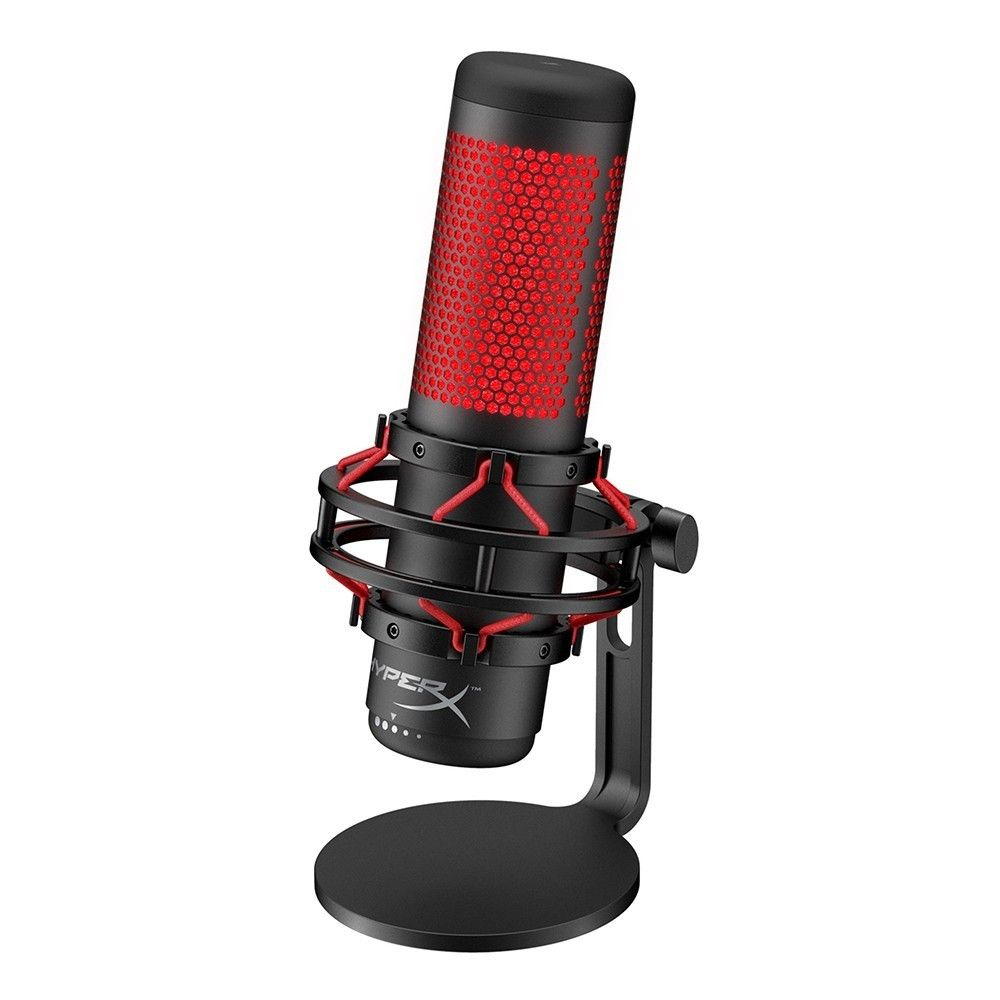
The HyperX QuadCast stands out in the gaming microphone space for its blend of style and substance. Right out of the box, the QuadCast impresses with its sleek design — the red and black color scheme screams ‘gamer’ without being overbearing. Aesthetics aside, it’s a solid performer that captures clear and detailed audio, which is paramount for in-game communication and live streaming. An aspect that I find particularly convenient is the tap-to-mute functionality at the top of the microphone, which is both practical and satisfying to use. The built-in shock mount and pop filter are details that show HyperX understands the nuisances of recording: no one likes post-editing unwanted bumps and plosive noises. It’s USB connectivity and plug-and-play design take the hassle out of setup, which is a huge plus for gamers who’d rather focus on gaming than on tech troubleshooting.
Specs:
- Microphone Type: Condenser
- Polar Patterns: Stereo, Omnidirectional, Cardioid, Bidirectional
- Frequency Response: 20Hz – 20kHz
- Connectivity: USB
- Built-in Shock Mount and Pop Filter
- RGB Lighting: Yes
Pros:
- Versatile with four selectable polar patterns, allowing for different recording scenarios.
- The tap-to-mute sensor is intuitive, complete with an LED indicator that shows the mic’s status, reducing potential for accidental live hot-mic situations.
- Inherent shock absorption and pop filter significantly enhance recording quality without needing additional accessories.
- It’s straightforward to install and use, making it accessible even for those new to using external microphones.
Cons:
- It is slightly bulkier than some competitors, which might be a consideration if desk space is at a premium.
- The gaming-centric design may not appeal to those looking for a more professional aesthetic.
- RGB lighting, while a pro for some, might be considered unnecessary and a bit distracting for others.
Price:
The HyperX QuadCast usually retails for around $140. While not the cheapest option on the list, the premium you pay is justified by the comprehensive feature set and the quality of the build. It’s a mid-range price point that hits the sweet spot for serious gamers and streamers who want quality without spending a small fortune.
In conclusion, the HyperX QuadCast is a well-rounded microphone that ticks off most of the requirements for a gaming-focused setup. The thoughtful design elements combined with the clear audio quality make it a standout choice. Whether streaming your favorite game or chatting with friends on a voice call, the QuadCast hardly misses a beat. The price reflects the value you get, making it a worthwhile investment for those looking to enhance their gaming audio setup.
Rode NT-USB Microphone
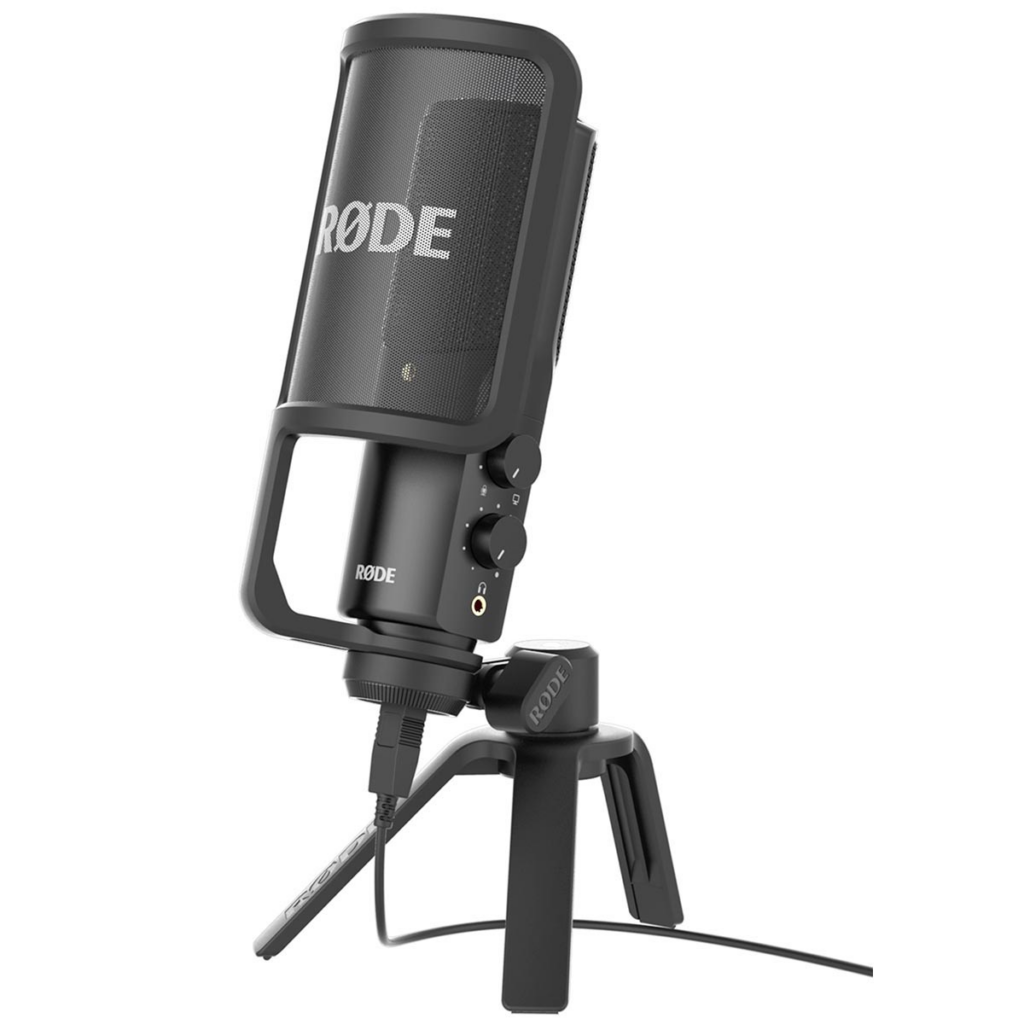
The Rode NT-USB is a highly versatile side-address microphone that is ideal for the gaming community as well as YouTubers, podcasters, and musicians. Its studio-grade quality and crisp, clear audio capture are what set it apart from most plug-and-play mics. The NT-USB’s sleek design and ease of use make it suitable for both beginners and professionals. The inclusion of a pop shield, tripod desk stand, ring mount, storage pouch, and USB cable means you can get started straightaway. What’s notable about the Rode NT-USB is its direct mix control between mic input and source output, which provides a perfect blend for gamers who need to monitor their audio in real-time.
Specs:
- Acoustic Principle: Pressure Gradient
- Active Electronics: JFET impedance converter with a bipolar output buffer, A/D converter 16bit 48kHz
- Frequency Range: 20Hz – 20kHz
- Maximum SPL: 110dB SPL
- Power Options: USB powered
- Output Connection: USB
Pros:
- Excellent sound quality with clear and precise audio capture.
- Zero-latency monitoring is ideal for gamers who need real-time feedback on their audio.
- Inclusion of a pop-shield and a decent quality tripod adds value for those who may not have an existing setup.
- Easy setup and compatibility with multiple operating systems simplifies the user experience.
- The build quality is robust, ensuring durability, which is important for gamers who might frequently be adjusting and moving their equipment.
Cons:
- It’s on the pricier side compared to some other gaming microphones, which could be a deterrent for those on a tight budget.
- No XLR output, which means it’s not as flexible for those wanting to upgrade to professional audio interfaces in the future.
- Its size and shape might not blend in well with all gaming setups, particularly where space is at a premium.
Price:
The Rode NT-USB tends to vary in price, typically falling between $160 to $200. Its higher price point is justified by its professional-level audio quality and solid build, but it still might stretch the budget for some users.
As someone who has a keen interest in gaming and has used a variety of microphones, I’ve found the Rode NT-USB to be a standout option for serious gamers looking to elevate their audio experience. The superior sound quality improves both the gaming experience and audience engagement during live streams or recordings. The mic’s immediate plug-and-play functionality negates the need for additional equipment or complex setups, making it incredibly user-friendly. You truly get what you pay for, and for those willing to invest in their gaming setup, the Rode NT-USB is a sound choice that won’t disappoint.
Certainly! Here is a review for the Elgato Wave 3 as part of your listicle review of the “best external microphone for gaming”:
Elgato Wave 3
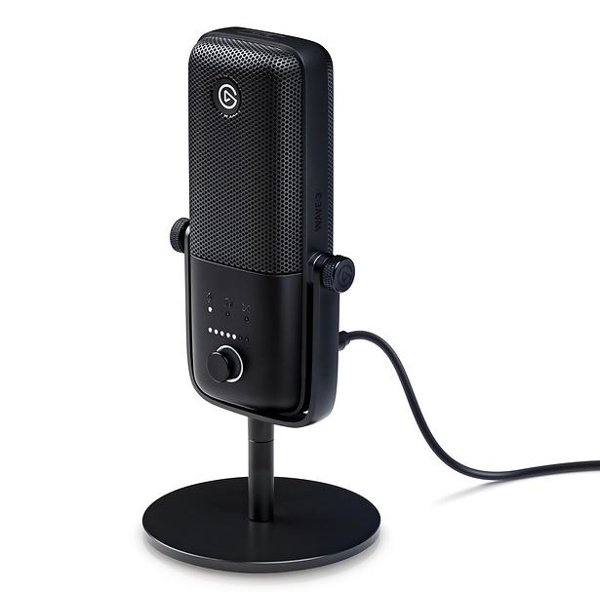
The Elgato Wave 3 is a premium USB microphone designed for streamers and gamers who demand high-quality audio without requiring professional audio engineering knowledge. Finished in a sleek, modern design that looks great on camera, the Wave 3 not only offers exceptional sound quality but also comes with user-friendly features such as a capacitive mute button and a proprietary Clipguard technology that prevents sound distortion. Its plug-and-play functionality means you can get it out of the box and into the game in no time at all.
Based on my hands-on experience, the Wave 3 really stands out for its crisp audio capture, which is especially noticeable when delivering commentary over intense gaming sessions. The Wave Link software included is another standout feature, as it allows you to mix multiple audio sources with ease – a fantastic tool for streamers who need to manage game sound, voice chat, and background music simultaneously.
Specs:
- Capsule Type: Condenser
- Polar Patterns: Cardioid
- Connection: USB-C
- Frequency Response: 70Hz – 20kHz
- Sample Rate: 96kHz
- Bit Depth: 24-bit
- Onboard Controls: Gain knob, Mute button, Headphone volume
- Software: Wave Link digital mixing solution
Pros:
- Superior audio clarity, making your voice sound professional and precise.
- Clipguard technology automatically reduces sudden volume peaks to avoid distortion.
- The Wave Link software provides an intuitive mixing experience.
- Sleek and sturdy build that will last and look good on any desk.
- Easy-to-use controls and a simple setup process.
Cons:
- Only one polar pattern (Cardioid), which might limit versatility compared to others with multiple patterns.
- Some users may prefer physical buttons over the capacitive touch mute functionality.
- Price may be higher compared to entry-level mics, potentially making it less accessible for budget-conscious gamers.
Price:
The Elgato Wave 3 generally retails around $160, which places it in the mid-to-high range of the market for USB microphones. While it is not the cheapest option available, the price is justified by its advanced features and the high-quality audio it provides.
In conclusion, the Elgato Wave 3 strikes a balance between advanced functionality and user-friendliness that many competitors lack. Whether you are deep into streaming or looking to provide crystal-clear voice communication in games, the Wave 3 could very well be the mic to elevate your gaming setup. Its drawbacks are minor and don’t detract from an overall impressive performance. If the price is within your budget and you’re looking for a near-professional audio solution, the Elgato Wave 3 should definitely be on your radar.
Title: Best External Microphone for Gaming
Today, I want to talk about a crucial piece of gear for any gamer who wants to improve the quality of their live streams, broadcasts, or voice chats — the external microphone. There’s an array of options out there, but I’m zooming in on a particular favorite that stands out in terms of quality and performance: the Audio-Technica AT2020USB+.
Audio-Technica AT2020USB+
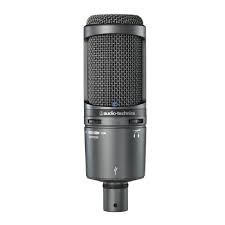
Overview:
The Audio-Technica AT2020USB+ isn’t just a microphone; it’s an investment in crystal-clear communication. As someone who’s used this in various scenarios, what stands out immediately is the purity of sound it captures — it’s like this mic was born to make your voice the star of the show. Whether you’re shouting instructions in an intense gaming session or casually chatting with your stream audience, the AT2020USB+ ensures you’re heard loud and clear, without those annoying background noises.
Specs:
The AT2020USB+ flaunts a cardioid polar pattern, which is geek-speak for “it picks up sound really well from the front and sides but not so much from the back.” This specificity is great for gaming environments where you don’t want your clacking keyboard to steal the spotlight. The mic also features a built-in headphone jack with volume control, allowing you to monitor your audio in real-time — a feature I find extremely helpful during live sessions.
Pros:
- The sound quality is superlative; your voice comes through warm and clear, which is impressive for a USB mic.
- The cardioid pattern is stellar at isolating your voice from background hubbub.
- Real-time audio monitoring is a boon for live adjustments without needing extra gear.
Cons:
- It’s on the pricier end, which might be a hurdle for budget-conscious gamers.
- The lack of multiple polar patterns can be a downside for those seeking versatility beyond solo use.
Price:
Regarding cost, the AT2020USB+ is definitely positioned as a mid-range-to-premium microphone. You’re not just paying for a brand name; you’re investing in quality that would be immediately noticeable in your audio output. Prices fluctuate based on retailers and sales, but you’re generally looking at an investment of around $150 to $200 USD.
In my opinion, if you’re serious about your gaming and your online presence, the Audio-Technica AT2020USB+ is a worthy addition to your setup. It straddles the line between professional-grade recording and consumer accessibility, making it an excellent choice for gamers who demand quality without needing an audio engineering degree.
Conclusion:
Choosing the perfect external microphone for gaming can elevate your experience to pro levels, ensuring crystal clear communication and immersive audio capture. Whether you’re streaming, recording, or in the midst of intense gameplay, the right mic can make all the difference. Keep in mind factors like audio quality, durability, and ease of use as you select from our top picks. Remember, a good gaming microphone not only enhances your voice but also brings out the best in your gaming escapades.
While desktop microphones have their strengths, gamers who prefer flexibility and mobility should consider exploring compact wireless lavalier microphones. These small yet powerful solutions provide crystal-clear audio, allowing gamers to stream or communicate smoothly without cluttering their setup.
FAQs:
- Do I need a special microphone for gaming?
While you don’t need a ‘gaming-specific’ microphone, using one designed for gaming can significantly improve audio quality and reduce background noise, making your communication clearer. - What is the difference between USB and XLR microphones?
USB microphones are easy to use and can be directly connected to your PC, while XLR mics often provide better sound quality but require additional equipment like an audio interface. - Is a pop filter necessary for gaming microphones?
While not essential, a pop filter is beneficial as it helps to reduce or eliminate popping sounds and can help protect the microphone from saliva and other particles.

































.png)




.png)


